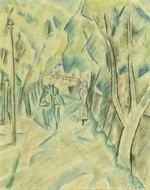Biography
Ignaz Epper was the son of the embroidery designer Karl Ignaz Epper and grew up in poor circumstances. After completing the convent school in St. Gallen, Epper trained as an embroidery draughtsman from 1908 to 1912 and met Sophie Taeuber-Arp, Sebastian Oesch and Theo Glinz at the École des arts décoratifs in St. Gallen.
After the recruit school Epper worked as a designer in the St. Gallen company “Selig” and was sent by his employer to Berlin to make fashion drawings.
Here he decided on a career as an artist and quit the job against the will of his parents. Like Adolf Dietrich, Epper was an autodidact. From Berlin he travelled with his artist friend Sebastian Oesch for several months to Weimar and Munich. Thanks to the drawings from this time, Epper received a Swiss Federal Art Scholarship in 1913.
In 1913 Epper began an apprenticeship as a lithographer at the “Seitz” company in Zurich. During his active military service as a border guard during World War I, he met his patron and patron Han Coray in Zurich. Epper was able to set up his studio over the premises of his book and art shop on the Obere Mühlgasse in Zurich and exhibit his early works, including woodcuts and linocuts, in the gallery. In the first years of the First World War Epper was intensively occupied with Saint Sebastian. Between 1913 and 1918 he created at least two woodcuts, a lithograph, some drawings and three oil paintings with this motif.
In 1916 he married the Dutch sculptor Mischa Quarles van Ufford and moved into an apartment on Spiegelgasse, which soon became a meeting place for painters, writers, architects and sculptors. Epper was nicknamed “hedgehog” by his friends because of his melancholy and secretive nature.
In Basel in 1917 he met Paul Ganz, the curator of the Kunstmuseum Basel, and Fritz Eduard Pauli. He travelled regularly with his wife, often accompanied by his friend Pauli and his wife, to the Netherlands, France, Spain, North Africa and Italy. During these extensive travels, he created numerous works in various techniques.
Epper regularly took part in the group exhibitions of the GSMBA and also exhibited in Zurich galleries. He was a member of the graphic arts association “Die Walze” and the “Graphisches Kabinett”.
From 1933 until his death in 1969 Epper lived in the “Casa Epper” in Ascona. In Ascona he also had lively contact with his artist friend from the Zurich years, Johann Robert Schürch, who lived there. Epper’s productivity decreased noticeably in Ascona and he now executed his works increasingly in oil and watercolor. In the following years he often travelled to Paris, Arosa and Collioure.
Epper illustrated the book by Charles-Ferdinand Ramuz, Bergsturz auf Derborence, which was published in 1935, and in 1937 he and his wife founded the puppet theatre of the Ascona artists. In the years before his death Epper studied the writings of Carl Gustav Jung and those of the Eranos circle in Ascona.
Epper’s works have been exhibited in the Kunstmuseum Olten, Kunstmuseum Winterthur, Kunstmuseum Thurgau, Kunsthalle Bern, Kunsthalle Basel, Kunstmuseum Lucerne, Kunsthaus Zug, Kunsthaus Aarau and the Kunsthaus Zürich, among others.
In 1974, the Ascona-based “Fondazione Ignaz e Mischa Epper” was founded and in 1980 the “Museo Epper” opened.
